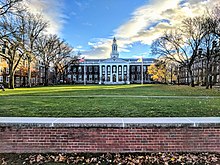Source: NYMag, May 2020
The post-pandemic future, he says, will entail partnerships between the largest tech companies in the world and elite universities. MIT@Google. iStanford. HarvardxFacebook. According to Galloway, these partnerships will allow universities to expand enrollment dramatically by offering hybrid online-offline degrees, the affordability and value of which will seismically alter the landscape of higher education.
Galloway, who also founded his own virtual classroom start-up, predicts hundreds, if not thousands, of brick-and-mortar universities will go out of business and those that remain will have student bodies composed primarily of the children of the one percent.
The value of education has been substantially degraded. There’s the education certification and then there’s the experience part of college. The experience part of it is down to zero, and the education part has been dramatically reduced.
You get a degree that, over time, will be reduced in value as we realize it’s not the same to be a graduate of a liberal-arts college if you never went to campus. You can see already how students and their parents are responding.
There will be a dip, the mother of all V’s, among the top-50 universities, where the revenues are hit in the short run and then technology will expand their enrollments and they will come back stronger. In ten years, it’s feasible to think that MIT doesn’t welcome 1,000 freshmen to campus; it welcomes 10,000.

What that means is the top-20 universities globally are going to become even stronger. What it also means is that universities Nos. 20 to 50 are fine. But Nos. 50 to 1,000 go out of business or become a shadow of themselves. I don’t want to say that education is going to be reinvented, but it’s going to be dramatically different.
The strongest brand in the world is not Apple or Mercedes-Benz or Coca-Cola. The strongest brands are MIT, Oxford, and Stanford.
The most value-added part of a university is not the professors; it’s the admissions department.
They have done a fantastic job creating the most thorough and arduous job-interview process in modern history, between the testing, the anxiety, the review of your life up until that point, the references you need. If I’m applying for a job at New York Magazine, I’d give you a list of references and you’d call them. You don’t ask the references to write a two-page letter. Universities now do background checks to see if you’ve ever had a DUI or been accused of a crime. They look at your social media to see if you’re abusing alcohol or if you’ve made racist or bigoted statements. We’re screening people like crazy.
When you go to Penn, you know that your classmates are solid citizens who are qualified and have good EQ [emotional quotient]. There is an opportunity for new companies to figure out testing and research methods to certify people around certain skills or EQ.
So far, no one has really come up with the ability to certify to the same extent that universities do. To a certain extent, Google, Apple, Amazon, and Facebook are also in the business of certification. If you get a job at Google, there’s a certain belief that the HR department has vetted you enough to certify that you have very strong skills. There will be opportunities in certification that aren’t universities.
In the case of MIT, Harvard, Stanford, and Cal, people will say they’re sacrificing their standards to enroll more students. The reality is these schools can double or triple their enrollments without sacrificing anything in terms of their brands.
Right now, their admissions officers are choosing between Magic Johnson and LeBron James. Every superstar in high school — and there are a lot — wants to go to these universities. We’re going to see schools slicing and dicing programming and product management, and they will have a new weapon: remote learning. The best universities are going to be able to expand enrollment dramatically, which will result in chaos for the tier-two and tier-three school. Nobody’s going to enroll in Pepperdine if they get into UCLA.
The cruel truth of what pretends to be a meritocracy but is a caste system is that your degree largely indicates or signals your lifetime earnings.
When kids get out of business school, they say, “I have an offer from Amazon and I have an offer to go to work for a regional bank, and I’d much rather go to work at a regional bank.” I just tell them, “Stop wasting my time. You’re going to work for Amazon.” Because when you go to work for Amazon out of business school, your career launches at a much greater angle. Going to UCLA versus Pepperdine starts you at a 10 to 30 percent higher salary coming out of school, which, over the course of your lifetime, when you add in salary increases, just creates a different life.
You think MIT and Google will be able to put out an online curriculum that will be worth paying tens of thousands of dollars or hundreds of thousands of dollars?
Yeah, because they’ll have some sort of hybrid model that will involve some in-person work. MIT’s certification — and that education that it’ll be able to string together using its faculty and its brand and the technology of a place like Google — will still be worth that kind of money. The reality is an MIT degree is still worth a quarter of a million dollars in tuition.
Is there something about the campus environment that exposes young people — who are more creative, greater risk-takers, and more fearless — to the world and our problems and gives them the opportunity to craft better solutions? Will big tech’s entry into education reduce our humanity or create a net gain in stakeholder value?















